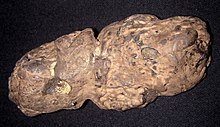The Aquia Formation is a geologic sandstone formation that extends from the upper Chesapeake Bay to the James River near Hopewell, Virginia.[1] It consists of clayey, silty, very shelly, glauconitic sand.[1] Fossil records indicate that this stratigraphic unit was created during the Paleocene.[1]
| Aquia Formation | |
|---|---|
| Stratigraphic range: Late Paleocene ~ | |
 Boulder of Aquia Formation along Chester River. Contains casts of large mollusks. (c. 1917) | |
| Type | Geological formation |
| Unit of | Pamunkey Group |
| Sub-units | Paspotansa & Piscataway Members |
| Underlies | Nanjemoy Formation |
| Overlies | Brightseat Formation |
| Thickness | up to 100 feet (30 m) |
| Lithology | |
| Primary | Sandstone |
| Location | |
| Location | Hopewell, Virginia |
| Coordinates | 38°18′N 77°18′W / 38.3°N 77.3°W |
| Approximate paleocoordinates | 39°00′N 58°54′W / 39.0°N 58.9°W |
| Region | Maryland, New Jersey, Virginia |
| Country | |
| Extent | Upper Chesapeake Bay-James River |
| Type section | |
| Named for | Aquia Creek |

The Aquia formation was named for Aquia Creek where it is exposed in cliff faces along the banks.[2]
Geology
editLithology
editWhen uncovered, it appears dark green to gray-green, argillaceous, with well sorted fine- to medium-grained sand and locally indurated shell beds.[3] It is between 0 and 100 feet thick in Maryland.[3] Quartz and phosphatic pebbles and/or very coarse glauconitic quartz sand mark the base of the unit.[4] A few hard streaks of shells or thin "rock" layers are often reported but appear to be more abundant in the sections south of the James River.[4]
Stratigraphy
editThe Aquia formation is overlain by the Nanjemoy Formation and overlies the Brightseat Formation.[5]
The Aquia formation is broken down into two members: the lower Piscataway member and upper Paspotansa member.[2]
Age
editThe Aquia Formation is thought to be 59.0-55.5 million years old.[2] The Piscataway member is 59–56.25 million years old, and the Paspotansa member is 56–55.5 million years old.[2] This is the Paleocene period.
Older publications describe the Aquia as being of Eocene age.[6]
Fossils
edit- Abdounia beaugei[2][7]
- Anomotodon novus[2][8]
- Carcharias hopei[2][8]
- Cretolamna appendiculata[2][8]
- Delpitoscyllium africanum[2]
- Foumtizia abdouni[2]
- Galeorhinus[2]
- Ginglymostoma subafricanum[2]
- Heterodontus lerichei[2]
- Hypotodus verticalis[2]
- Isurolamna inflata[2]
- Megasqualus orpiensis[2]
- Notidanodon loozi[2]
- Odontaspisx loozi[2]
- Orectolobiform[2]
- Otodus obliquus[2][9][8]
- Pachygaleus lefevrei[2]
- Palaeogaleus[2]
- Paleocarcharodon orientalis[2][9][8]
- Paleohypotodus rutoti[2][10]
- Paraorthacodus clarkii[2]
- Physogaleus secundus[11]
- Premontreia subulidens[2]
- Scyliorhinus[2]
- Squalus
- Squatina prima[2]
- Striatolamia macrota[2][8]
- Striatolamia striata[2]
- Triakis[2]
- Myliobatis[12]
- Burnhamia[2]
- Coupatezia soutersi[2]
- Dasyatis[2]
- Hypolophodon sylvestris[2]
- Ischyodusx sylvestris[2]
Mammal fossils are extremely rare.[2]
Bird fossils are extremely rare.[2]
- Turritella is very common.[2][8][15]
- Pleurotoma potomacensis[16]
- Crassatelites alaeformis[16]
- Cucullaea gigantea[17][16][18]
- Dosiniopsis lenticularis[16]
- Meretrix ovata[16]
- Modiolus alabamensis[16]
- Ostrea compressirostra[19][16]
- Panopea elongata[16]
- Venericardia planicosta[16]
- Vulsella alabamensis[19]
See also
editReferences
edit- ^ a b c Geology of the National Capital Region - Field Trip Guidebook. Reston, Virginia: U.S. Geological Survey, Department of the Interior. 2004. p. 270.
- ^ a b c d e f g h i j k l m n o p q r s t u v w x y z aa ab ac ad ae af ag ah ai aj ak al am an ao ap aq ar Phatfossils Aquia Formation in Maryland and Virginia
- ^ a b "Coastal Plain Rocks and Sediments". Geological Maps of Maryland. Maryland Geological Survey. 1968. Retrieved 21 January 2015.
- ^ a b Powars, D.S.; Bruce, T.S. (2000). The Effects Of The Chesapeake Bay Impact Crater On The Geological Framework And Correlation Of Hydrogeologic Units Of The Lower York-James Peninsula, Virginia. United States Geological Survey. Retrieved 22 January 2015.
- ^ Page, Richard A (1959). "The Questionable Age of the Aquia Formation". Journal of Paleontology. 33 (2): 347–350. JSTOR 1300764.
- ^ Tolchester folio, Maryland, Folios of the Geologic Atlas 204, by B. L. Miller, E. B. Mathews, A. B. Bibbins, and H. P. Little, 1917.
- ^ Elasmo.com, The Life and Times of Long Dead Sharks, Abdounia, Jim Bourdon, author.
- ^ a b c d e f g h i j k "Fossil Identification for the Potomac River".
- ^ a b "Potomac - Aquia Formation 3/15/18".
- ^ "Paleohypotodus?".
- ^ "Physogaleus secundus".
- ^ "Myliobatis".
- ^ "Thecachampsa".
- ^ "Trionyx".
- ^ "Turritella sp".
- ^ a b c d e f g h i Virginia Division of Mineral Resources (1912). Bulletin. p. 200.
fossils of the aquia formation.
- ^ "Cucullaea Gigantea". 15 May 2010.
- ^ "Views of the Mahantango: Cucullaea gigantea pelecypod from the Aquia Formation". 11 August 2014.
- ^ a b "Ostrea compressirostra".
- ^ "Sanity check: It's a Nautilus, right?".